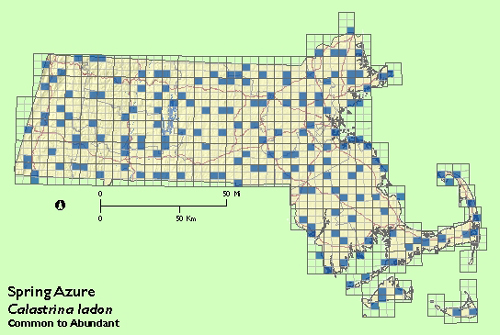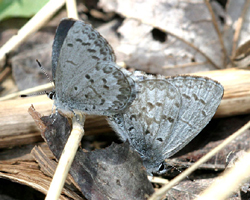Butterfly Atlas
Find a Butterfly
Spring Azure
Celastrina ladon
Named
Cramer, 1780

Taxonomy & Nomenclature
The many geographical and seasonal variations of this abundant and widespread species have given rise to several taxonomic interpretations, resulting in a confusing array of named species, subspecies and forms in the literature. In some recent works the present species is referred to as Celastrina argiolus, i.e. conspecific with the Old World Holly Blue. The closely related Appalachian Blue (C. neglectamajor), which occurs within the range of the present species was formerly considered a form of C. ladon.
Identification
Wingspan: 3/4 - 1 1/4". This and Appalachian Blue are easily distinguished from any other small blue butterfly in the Northeast by the underwing pattern: this lacks any orange spottings along the margin of the hind wing and the markings are always relatively slender and linear compared to the bold dots of Silvery Blue.
Eastern Tailed Blue, the only other common blue in New England is distinctly smaller with conspicuous orange hind wing spots and "tails".
Spring Azure is smaller than Appalachian Blue with a more complex and generally darker underwing pattern; see under the latter species.
In both Celastrinas of the region the females differ from the males in having some degree of dark border along the leading edge of the forewings above and a row of dark spots along the margin of the hind wings above. In late spring and summer forms the hind wings (and sometimes the forewings) may be extensively white above. The shade of blue also varies seasonally. For more detailed accounts and illustrations of this bewildering complex of forms see Howe (1975), Opler and Krizek (1984), Scott (1986), and Wright (1995).
Distribution
Throughout North America south of the tundra from near the Arctic Circle in Alaska east to Newfoundland, southward to central Mexico. Absent only from parts of Texas, coastal Louisiana and most of the Florida peninsula. Occurs throughout New England.
Status in Massachusetts
Common to abundant in appropriate habitat throughout the state, and not unlikely to be seen in Boston city parks. The Spring Azure‘s status appears not to have changed markedly since Scudder‘s time despite the great changes in the vegetational cover of the state during the last 150 years. Maxima: 153, 14 May 1992, Plymouth (Plymouth Co.).

Flight Period in Massachusetts
Flies almost continuously from the first warm days of April until the beginning of September. This represents two different broods and a continuous, but variable, sequence of emergences. The species as a whole is most abundant from late April to mid May, in early June and during the middle of July. Extreme Dates: 23 March 1990, Foxboro (Norfolk Co.), B. Cassie; August 22, 1989, Wellesley, R. Forster; 23 August 1994, Cape Ann (Essex Co.), D. Savich, C. Tibbetts. It is interesting that Scudder‘s earliest record for this species was April 14 (West Roxbury), while atlas workers collected 12 specimens on or before this date from 1986 to 1990.
Larval Food Plants
Feeds on the flower parts of a wide range of plants, mainly shrubs, depending upon what is in bud or bloom at the time of hatching. New England genera recorded in the literature include: dogwoods (Cornus), cherry (Prunus), shadbush (Amelanchier), blackberry (Rubus), meadowsweet (Spirea), viburnum (Viburnum, sumac (Rhus), blueberries (Vaccinium), maple (Acer), holly (Ilex), privet (Ligustrum), sarsaparilla (Aralia), bearberry (Arctostaphylos), colombine (Aquilegia), New Jersey Tea (Ceanothus), hops (Humulus), oak (Quercus), horse chestnut (Aesculus), honeysuckle (Lonicera), lupine (Lupinus), groundnut (Apios), hog peanut (Amphicarpa), bush clover (Lespedeza), sweet clover (Meliotis), horsebalm (Collinsonia), daisy (Chrysanthemum), and sunflower (Helianthus).
Adult Food sources
Adults were recorded on 21 different flower species during the atlas period (1986-90) and have been reported from many others in the literature. Opler‘s assertion (1984) that "Individuals of the first brood seldom visit flowers" does not seem to be true in Massachusetts (10 spring species noted). Males gather, often in large numbers on damp ground: puddle edges, stream banks, etc., and they are also attracted to carrion and excrement.

Habitat
Open deciduous woodlands (wet or dry) and old fields that have grown up to shrubs. Often common along roads and wooded edges. Generally avoids fields and other extensive open habitats.
Life Cycle
EGG: A flattened dimpled cushion covered in raised points alternating with depressions, the depressions pale green, the points white. OVIPOSITION: Eggs inserted singly among flower buds of a wide range of larval food plants, mainly shrubs (See above); hatching in four to eight days. LARVA: Slug-shaped; varies in color -- whitish, buff, green or pink with darker back and side stripes, covered with fine short hairs. The caterpillar feeds on flower parts (rarely leaves). In later stages the larvae is tended by ants which stimulate it to excrete a clear greenish "honeydew" from top of the seventh abdominal segment. The presence of the ants is presumed to discourage parasitism by wasps and flies. CHRYSALIS: Light brown to brownish yellow with black markings; smooth, ovoid. PUPATION: In a crevice or on the ground. OVERWINTERING STAGE: Chrysalis.
While overwintering Nymphalis species sometimes emerge during early thaws in March, this is the true butterfly harbinger of spring, first adults typically emerging from their chrysalids in mid to late April. According to Opler (1984) courtship activities of Spring Azures peak "from midafternoon to almost dusk". Individuals live only a few days, females typically emerging and mating on the same day and laying eggs on the next, rarely surviving another day or two.
Notes
Scudder (1889) notes that Spring Azures "have been known to fly at night to the electric light!". While localized colonies persist, individuals of this species are also known to wander widely to considerable distances laying eggs on appropriate food plants.
Account Author
Chris Leahy



